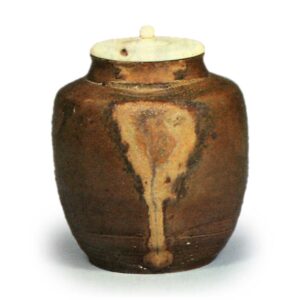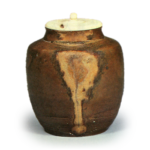
A potter from Seto, Owari, Japan. First Fujijiro, and then, according to one theory, Fujikuro or Fujigoro. He inherited the main family during the Bun’ei period (1264-75). He produced many Kiseto and Hakuan handles. This type is called “Manchu Ko-kono” to distinguish it from Keisho’s Koseto. The characteristics of Manchu Kowan tea caddies are that the mouths are made with chopsticks and the clay is white or white asagashige, and some are extremely pale red with a hint of sandy air. The overglaze glaze is persimmon or light persimmon color. The overglaze is black, but many of them have a yellow glaze with a black glaze with a black hemidashi, and some have a blown out glaze with a silver nashiji. Next are yellow-glazed tea caddies, the clay of which differs from that of the old type in the middle of the year in that it is red with a slight black tinge. The underglaze glaze is a light chestnut color, and some have a light persimmon color. The dark yellow glaze without luster is applied on top of it. Some of the pieces are wavy, while others are not. The quality is good.
The works of the Manchuko-gama include Noda-te, Hashi-hime-te, Shigawa-te, Daibe-te, Daikakuji-te, Mendori-te, Ogawa-te, Fujishiro, Yanagi Fujishiro, Itome Fujishiro, and Mushi-meshi Fujishiro. Some people call the works of the Manchuko-gama simply “Fujishiro. In addition, there is a tea caddy that is said to have been fired in the grandmother’s baie kiln by the second generation. See the section on “Grandmother’s Pocket. (Kokin Meimono Ruiju, Honcho Pottery Novelogue, Chado Sentei, Kogei Shiryo, Koryo Chawan and Seto Chajiryu, etc.)








